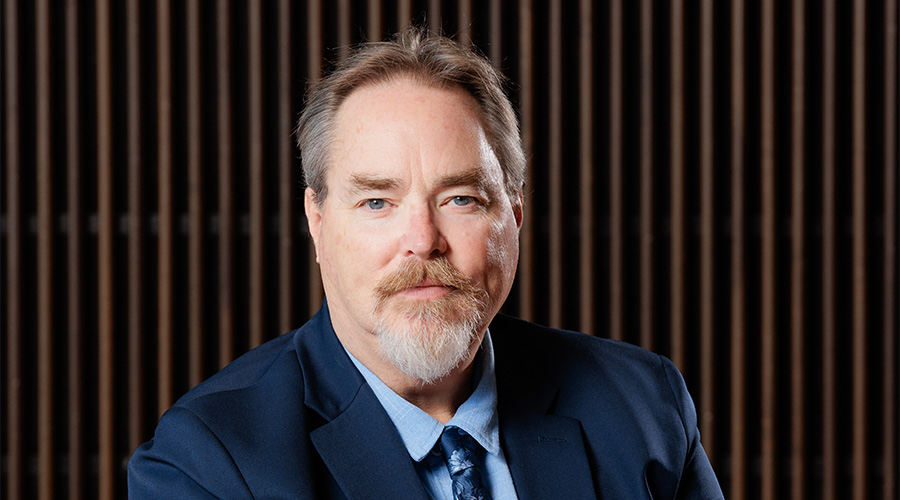 Clarence Carson was hired as the Chief Facilities Officer of Chicago Public Schools in May 2018. Kai Brown Photography
Clarence Carson was hired as the Chief Facilities Officer of Chicago Public Schools in May 2018. Kai Brown PhotographyWindy City Revival: How One FM Turned Around Chicago Public School Facilities
Clarence Carson reorganized facility management at Chicago Public Schools. The results have been a more efficient operation and happier occupants.
Clarence Carson was only acting as an involved parent when his young daughter nominated him to be the PTA treasurer at her small Chicago school. He had no idea that Kristina was placing him on a career path he never saw coming.
“I went from being the PTA treasurer to the chief facilities officer (CFO) at the third largest school district in the country,” Carson says.
The path wasn’t that easy. But Carson’s background in construction and facilities management, combined with his successful effort to spearhead needed upgrades at a small, aging school, grabbed the attention of Chicago Public Schools (CPS) officials who wanted him to transform an entire district in the way he did Kristina’s school, McDade Classical, on Chicago’s Southside.
“I was looking for a rock star, knowing that facilities management was a major vulnerability for the school district,” says Arnie Rivera, at the time the chief operating officer (COO) at CPS. “Clarence did not apply and had zero interest. I sought him out. I don’t think he was exactly champing at the bit to do it.”
On the radar
CPS was in a bad place when Rivera was hired as COO in February 2018. The district was receiving tons of bad publicity and its reputation was in tatters.
“Three weeks into my stint as chief operating officer, things blew up,” says Rivera, now the chief administrative and equity officer at Navy Pier in Chicago. “(We had) front page stories about how schools are dirty, and I was like, we can’t have this. This cannot be a major point of vulnerability for our district.”
The position of CFO at CPS was a revolving door, which did not help matters. At least four different people filled the position since 2014, “none of which had facilities management experience,” Rivera says.
It was a prime opportunity for Carson, who carried a deep background in facility management, starting with his education at Michigan State University, where he studied construction and facilities management, and earned a Masters in construction management with a minor in urban renewal planning. After graduating, he worked for years in the private and public sector, mostly in Chicago.
“It’s not a huge degree program around the country. It’s pretty rare and I was the only minority and non-white student in my undergrad and only one of two Americans in my graduate program,” says Carson, who serves on the board for State’s alumni board for the construction management program and created a mentoring program for African-American students at the university. “It’s something I really wanted to do. I went through the progression on campus. I worked at the physical plant as a carpenter and later ended up being a project manager, actually managing construction projects on campus. Through the grad program I was a teaching assistant and grad assistant.”
Carson’s involvement in his daughter’s school could not have been more timely. As Rivera was settling into his new role, Carson was impressing district leaders with the work he did at McDade and two other small CPS schools, where he spearheaded renovations to expand the schools to teach up to 8th grade from 6th grade. To sell the projects, Carson emphasized communication between the parents, students, faculty, and staff, and eventually got his proposals passed.
“At the time, they told me it could never be done,” Carson says. “I put together an estimate, a design schedule, and an overall plan, and put together a survey for all the students and all the staff and administration and the community nearby as well as the community leaders. I was able to get us all on the same page as to how the school should go.”
The projects turned heads.
“After the presentation (at Dade), the board president looked at me and said, ‘Who are you?’ and I just said ‘I’m a dad trying to help the school’,” Carson says.
The three projects were approved in May 2018, and during the next month, CPS set its sights on Carson for a bigger role, offering him the position of CFO.
“They said they wanted me to do what I did at those schools, listening to principals, listening to teachers, listening to the community, and taking a thoughtful approach to building management, and the building upgrades, and ‘we’d like you to do that for all of our buildings’,” Carson says.
Task at hand
CPS faces a lot of the challenges public school districts face, such as lack of funding and major backlogs of deferred maintenance. At CPS, deferred maintenance totals reach $3.5 billion and many of its buildings are aged 80 years or older.
In a district that consists of 600 campuses and 1,300 buildings covering 69 million square feet, and services 355,000 students, and 50,000 faculty and staff members, changing ways can take awhile.
Carson’s main challenge was to take back control of managing facilities, which was being contracted out to large vendors in a managing model known as the integrated facilities management model.
“One of the major areas I saw that were in need of improvement were our overall services in the facilities department,” Carson says. “We went through several issues where some of the major complaints of our district came against the facilities department, either pest control issues, facility cleanliness conditions, building repair response, and timelines. Those were major issues that I knew of as a parent in the community.”
After surveying district principals on how they felt the facilities department was performing, Carson reached out to schools near and far to determine what was the best approach. The district eventually proceeded to adopt a facilities management office model, which fully takes effect in October as existing contracts with vendors expire.
While CPS will still rely on third-party companies for duties such as cleaning within the district, Carson has expanded the infrastructure within the department, adding directors and managers so that the district leaders have more oversight.
“Bringing on this model, I was able to change the staffing within our department,” Carson says. “When I first arrived here, there was primarily a chief facilities service officer, a director of operations, and that was it. That naturally did not address the key services within our department, and it did not create the pillars of leadership over each of these areas. I reorganized our department and created several new positions to help us be successful.”
Carson added new positions like directors of environmental safety, and directors of energy and sustainability, as well as senior managers of staffing operations, project controls, project management, and logistics.
“We’re going to grow out that team, have longer tentacles and provide even more control, more transparency, through direct control over the contracts through our departments,” Carson says.
Related Topics:












